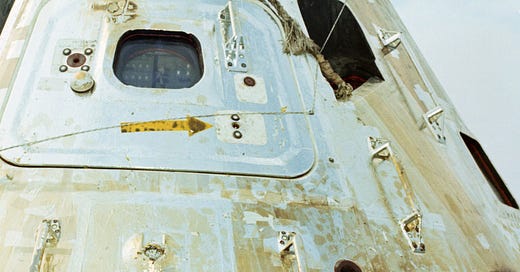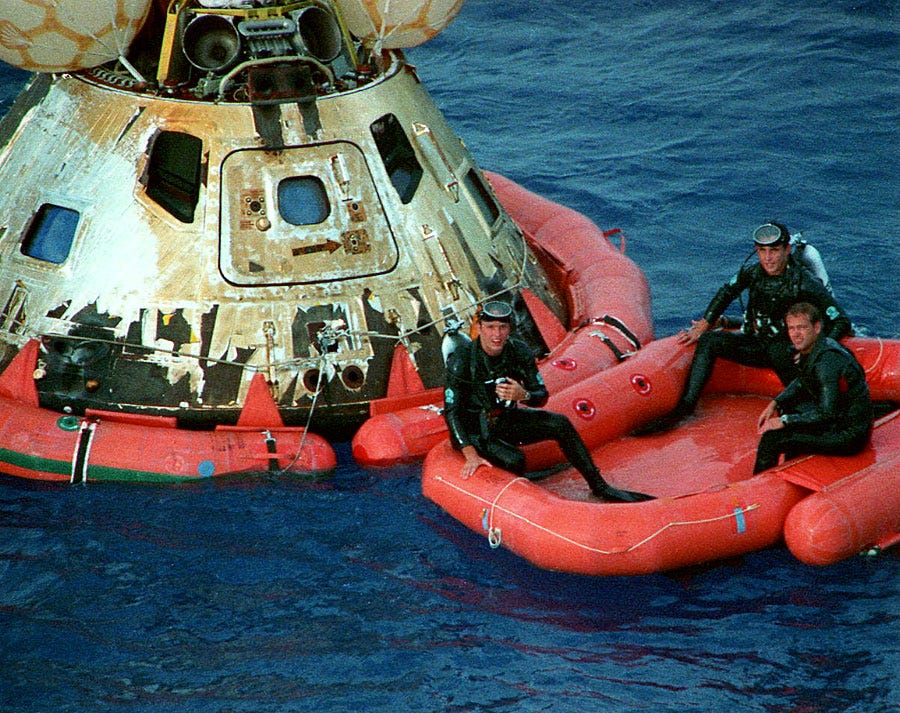All images in this article courtesy of NASA.
Looking at the Apollo program in detail, downloading technical reports, examining images and reading the accounts of the astronauts themselves reveals the power of magic, myth and legend.
To this day, NASA is hamstrung by this very Legend they created. The mission to return to the moon has been met with one delay after the other. And some of the delays in the Orion project involve issues that were supposedly solved by Apollo in the first place! Things such as heat shields, radiation protection for the crew, space suits for EVA and a powerful enough launch vehicle to get to the moon and back. These are mechanical and technical issues needed to be solved? It’s all rather peculiar and feeds hay to the Apollo Hoax crowd who grows fat over NASA’s dithering.
Many events of the Apollo era are confusing to understand. It may be that the majority of us who research it are not engineers or scientists. A lot of Apollo exploits appear to be a contradiction, or lack common sense, and can appear to the layman or the hoax believer as a “got ya” moment. It may just be a simple lack of understanding about how these systems work. Or, it may be Black Budget technology being employed. Something that will be forever out of reach in sussing out the truth.
Magic Handles
I first took note of the issue of handles on the Apollo capsule in the Aulis.com article, Getting a Grip on Apollo 11, by Emanuel E Garcia, MD. In this piece it is noted that handles outside of the Command Module capsule are made of aluminum. As stated by Dr. Garcia:
“As far as I can ascertain, the aluminum alloy used for the EVA handles was 2024-T3510 Aluminum, whose melting point is 1180 degrees Fahrenheit. For comparison’s sake, the melting point of Titanium is 3034 degrees Fahrenheit.”
Since reentry temperatures get as high as 5,000 degrees Fahrenheit, this far exceeds the heat tolerance of the handles. When seeing the images of the capsule after splashdown the handles are intact. So theoretically, the aluminum handles should have melted off. However, upon reentry, the spacecraft was in the “hot zone” for roughly 6 minutes. Maybe not enough time to melt the handles? Only until an investigator with an oven producing 5,000 degrees of heat will we be able to know how fast the 2024-T3510 Aluminum can actually melt.
Magic Glass
But aluminum handles are not the only thing past the heat endurance. A NASA document I downloaded called, CSM06 Command Module Overview listed the heat tolerance for the outer windows at 3110 degrees Fahrenheit. Once again, no windows melted upon reentry.
Should not at least the windows be rated for more than 5000 degrees? For crew safety? If those windows had been punctured from melting during reentry, the interior of the capsule would depressurize and the crew would have been incinerated in an inferno.
But neither the handles nor the windows suffered enough damage to have a catastrophic failure. Not like the O rings on the Space Shuttle’s boosters. So, were the handles and the windows fabricated from materials that are secret composites? Classified? Or were they just plain lucky?
There are a lot of things that went on in the development of the Apollo program where crew safety appears, if not actually, to be second place. There were a lot of things that were not tested. Nobody knew if the engines on the LM were going to function till they got to the moon—there was no test firing of the engines because every time they did, the engine would have to be rebuilt due to the corrosive contents of the fuel used. Once in the factory after a cabin pressurization test of the LM, a window blew out. The glass was vacuumed out of the cockpit and new glass was installed. The second pressurization worked. But there was no investigation as to the cause. This should have been done for crew safety but was not.
Getting to the moon was everything.
In Closing
So here is another mystery of the Apollo program. Non melting handles and windows when exposed to high temperatures. There are a lot of factors here such as the use of classified technology, exotic materials and the limited time in the not zone all contributing to the mystery. A hoax shouldn’t be the first and only answer we cling to. With NASA, in the end, we can never really know for sure.
Notes
Aulis states in their “Getting a Grip on Apollo 11” article that Apollo’s 12 and 13 were the only spacecraft with no handles on the exterior. They are in error. Both were fitted with handles as the pictures below indicate.
Sources
Getting a Grip on Apollo 11
https://www.aulis.com/handles.htm
Apollo Operations Handbook SM2A-03-BLOCK II-(1)
https://www.hq.nasa.gov/alsj/alsj-CSMdocs.html
Apollo 12 handles
https://www.nasa.gov/feature/50-years-ago-three-more-like-before-the-recovery-of-apollo-12/
Apollo 13 handles





